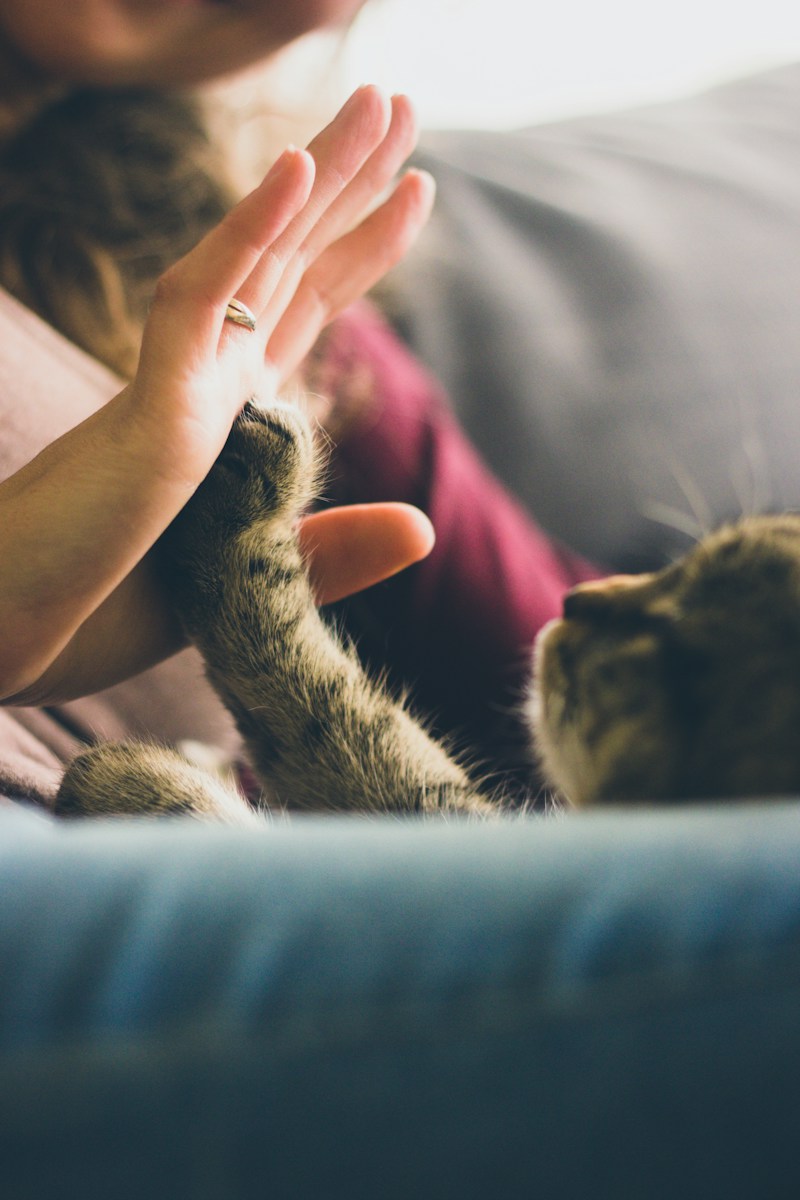
Animal-assisted therapy, commonly known as AAT or pet therapy, refers to a therapeutic approach that involves the incorporation of animals into the treatment process to enhance the overall well-being of individuals, particularly in the realm of mental health. This innovative form of therapy recognizes the unique bond between humans and animals and leverages it to achieve therapeutic goals. The presence of animals, such as dogs, cats, or horses, in therapeutic settings is harnessed to address various mental health issues, including anxiety, depression, and stress. As the understanding of the profound impact of the human-animal connection deepens, the importance of pet therapy is on the rise. Its effectiveness has been observed in diverse contexts, ranging from clinical settings to educational institutions, highlighting its versatility in promoting mental health and emotional well-being.
Brief presentation of the connection between animals and human well-being:
The profound connection between animals and human well-being is rooted in a long history of companionship and mutual support. Animals have a unique ability to offer unconditional love, companionship, and a non-judgmental presence, which can be particularly beneficial in the context of mental health. Research has consistently demonstrated that interaction with animals can lead to the release of oxytocin, a hormone associated with bonding and stress reduction. Beyond the biological aspects, the presence of animals often fosters a sense of responsibility, routine, and purpose, all of which contribute significantly to an individual’s mental and emotional stability. This inherent link between animals and human well-being serves as the foundation for the growing adoption of pet therapy as a valuable complement to traditional mental health interventions, ushering in a new era of holistic and compassionate care.
The foundations of pet therapy
Historical origins of animal-assisted therapy (AAT):
The historical roots of pet therapy can be traced back to ancient civilizations, where animals were recognized for their therapeutic potential. In ancient Greece, for instance, it was believed that interactions with animals could contribute to physical and mental healing. The modern concept of pet therapy began to take shape in the 20th century, with the pioneering work of individuals like Dr. Boris Levinson, who observed the positive impact of his dog on his patients during therapy sessions. Over time, the field has evolved, incorporating insights from psychology, medicine, and ethology. The recognition of the historical underpinnings of pet therapy emphasizes that the integration of animals into therapeutic practices is not merely a contemporary trend but a practice deeply rooted in the collective human understanding of the healing power of the animal-human bond.
Diverse approaches and techniques in animal-assisted therapy:
Animal-assisted therapy encompasses a spectrum of approaches and techniques tailored to address a variety of mental health concerns. One prevalent method involves incorporating animals into counseling or psychotherapy sessions, where interactions with the animals facilitate emotional expression and connection. Equine-assisted therapy leverages the presence of horses to promote emotional growth and personal development, while canine-assisted therapy often involves trained therapy dogs to provide comfort and support. Additionally, nature-based interventions, such as horticultural therapy, fall under the umbrella of pet therapy. The diversity of approaches in pet therapy underscores its adaptability to different therapeutic needs, allowing practitioners to tailor interventions based on the unique preferences and challenges of each individual.
Commonly used animals in animal-assisted therapy sessions:
The types of animals employed in pet therapy sessions are as diverse as the therapeutic approaches themselves. Dogs are perhaps the most widely utilized animals due to their innate ability to form strong bonds with humans and their intuitive understanding of emotional states. Cats, rabbits, and guinea pigs are also common companions in pet therapy, particularly in settings where a calm and gentle presence is beneficial. Larger animals like horses play a crucial role in equine-assisted therapy, contributing to the physical and emotional development of individuals. The selection of animals depends on the goals of therapy and the preferences of the individuals involved, highlighting the versatility and inclusivity of pet therapy in catering to a broad range of therapeutic needs.
The benefits of pet therapy
Positive impacts on mental health:
Pet therapy, with its unique integration of animals into therapeutic processes, has showcased remarkable positive impacts on mental health. One of its notable achievements is the substantial reduction of stress, anxiety, and depression in individuals undergoing therapy. The calming and non-judgmental presence of animals creates a comforting environment that encourages emotional expression and fosters a sense of security. Research studies have consistently highlighted the efficacy of pet therapy in alleviating symptoms associated with various mental health disorders, making it an increasingly sought-after complementary approach in mental health care. The interactive and relational nature of this therapy allows individuals to form bonds with animals, promoting emotional well-being and providing a holistic approach to mental health treatment.
Physical benefits of pet therapy, including lowering blood pressure:
Beyond its impact on mental health, pet thrapy has demonstrated notable physical benefits, contributing to an individual’s overall well-being. A significant physiological advantage is the reduction of blood pressure associated with regular interaction with therapy animals. The presence of animals has been linked to the release of endorphins and a decrease in cortisol levels, which collectively contribute to a lowering of blood pressure. This not only indicates the potential of pet thrapy in cardiovascular health but also underscores the interconnectedness of mental and physical well-being. As a non-invasive and enjoyable approach to health improvement, pet thrapy offers a holistic solution that considers the comprehensive health needs of individuals, recognizing the intricate interplay between mental and physical wellness.
Illustration of pet therapy success through case studies and testimonials:
The success of pet thrapy is further underscored by compelling case studies and heartfelt testimonials that highlight its positive impact in diverse contexts. Real-life examples provide tangible evidence of how pet thrapy has positively transformed the lives of individuals facing various mental health challenges. From children with autism spectrum disorders to veterans experiencing post-traumatic stress disorder (PTSD), the therapeutic alliance between humans and animals has proven to be a catalyst for positive change. These stories not only emphasize the versatility of pet thrapy but also serve as inspiration for those considering or undergoing such interventions, fostering a broader understanding of its potential benefits across different demographics and mental health conditions.
- Case study 1: Brandon, an adolescent with Bulimia, found solace in spending time with Emma, a miniature horse. This interaction helped him open up about his past, leading to improved coping skills and decreased anxiety.
- Case study 2: Sabrina, struggling with low self-esteem and depression, connected with Ottis, a Nigerian Dwarf goat. This bond helped her realize the potential to trust and take steps towards recovery.
- Case study 3: Alan, feeling inadequate and isolated, gained confidence and improved self-esteem through interactions with Therapy horse Jack. This helped him assert himself and communicate better.
- Rosewood’s AAT program: The program includes a variety of animal types and interventions, focusing on nurturing and well-being. It leads to personal realizations and increased self-nurturance among patients.
Pet therapy in the veterinary field
The role of animals in the healing process of veterinary patients:
In the realm of veterinary care, animals play a multifaceted and crucial role in the healing process of their fellow species. Beyond the physical treatments administered by veterinarians, the companionship of animals has been recognized as a powerful therapeutic tool. Veterinary patients often experience stress, anxiety, and discomfort, especially in clinical settings. However, the presence of fellow animals, whether in the form of therapy animals or even resident pets within the veterinary facility, can provide a source of comfort and companionship. This companionship goes beyond the usual human-animal bond, as animals have an innate ability to understand and empathize with the physical and emotional struggles of their counterparts. Whether it’s a therapy dog accompanying a recovering patient or a resident cat providing solace in a veterinary clinic, the role of animals in the healing process extends beyond the technical aspects of medical care to address the holistic well-being of the patients.
How animals contribute to easing the stress of ailing animals:
Animals, through their instinctive empathy and non-verbal communication, have a remarkable capacity to soothe and alleviate stress, even among their fellow species. In the context of veterinary care, where animals may be undergoing treatments, surgeries, or recovery, the introduction of animal companionship can significantly contribute to stress reduction. This is particularly evident in cases of hospitalization or extended stays for veterinary patients. The mere presence of a calm and reassuring animal companion can create a comforting environment, easing the stress and anxiety that animals often experience in unfamiliar and clinical settings. Veterinary professionals increasingly recognize the value of incorporating pet therapy into their practices to improve the emotional well-being of their patients, recognizing that a stress-free environment can positively impact the recovery and overall health of the animals under their care.
Examples of successful integration of pet therapy in veterinary clinics:
Numerous veterinary clinics around the world have embraced the integration of pet therapy with notable success. For instance, therapy dogs are employed to provide emotional support to animals recovering from surgeries or experiencing prolonged hospitalization. In some cases, resident animals within veterinary facilities, such as cats or rabbits, serve as constant companions to reduce the sense of isolation and distress in patients. Moreover, innovative programs have been implemented where animal-assisted activities are incorporated into rehabilitation regimens, fostering a positive and engaging atmosphere for the animals undergoing treatment. These examples underscore the versatility and effectiveness of pet therapy in veterinary contexts, demonstrating that the integration of animals into the healing process contributes not only to physical recovery but also to the emotional well-being of veterinary patients.
- AAI (animal assisted intervention) program wellness and welfare: The wellness of animals in AAI programs requires regular veterinary care, continuous monitoring, and involvement of veterinarians in all AAI programs. This ensures the health and welfare of both humans and animals involved.
- Preventive medical strategies: These include regular wellness visits, vaccination, parasite prevention, and behavioral evaluation to ensure the animals are suitable for AAI programs.
- Preventive behavioral strategies: Veterinarians must address behavioral health during wellness visits and ensure animals get regular play, quiet time, and rest separate from AAI activities.
- Other considerations: Training animals to avoid picking up things off the floor, coding systems in facilities to indicate no-animal zones, and retirement plans for therapy animals are essential for a successful AAI program.
Here’s one of website that I used for my researches that I found really interesting
Training and future perspectives
Training requirements to become a practitioner in animal-assisted therapy (AAT):
Embarking on a career as a practitioner in pet therapy entails a comprehensive understanding of both therapeutic techniques and animal behavior. Individuals aspiring to become practitioners typically pursue specialized training programs that encompass psychology, counseling, and veterinary sciences. These programs often integrate hands-on experiences, allowing future practitioners to develop the skills necessary for facilitating effective interactions between animals and individuals seeking therapy. Courses cover diverse topics, including animal behavior assessment, ethical considerations, and the integration of AAT into various therapeutic settings. Some practitioners may also choose to specialize in specific areas, such as pediatric or geriatric pet therapy. Certification from recognized institutions or professional organizations is commonly required, ensuring that practitioners meet established standards of competence. Continuous education is emphasized, reflecting the dynamic nature of the field and the ongoing research that contributes to the refinement of pet therapy practices.
Professional opportunities in the field of animal-assisted therapy (AAT):
The field of pet therapy offers a spectrum of professional opportunities for individuals with a passion for both animals and mental health. Practitioners may find employment in diverse settings, including hospitals, mental health clinics, schools, and rehabilitation centers. Beyond traditional clinical roles, opportunities also exist for AAT practitioners in community outreach programs, nursing homes, and correctional facilities. Some practitioners choose to establish their private practices, offering tailored pet therapy services. Additionally, the growing recognition of the benefits of AAT has opened doors for collaboration with other healthcare professionals, creating interdisciplinary teams to address complex mental health issues. As societal awareness of the positive impact of animals on well-being continues to expand, the demand for trained professionals in pet therapy is expected to rise, providing a promising landscape for those entering the field.
Future developments and trends in animal-assisted therapy (AAT):
Looking ahead, the future of pet therapy holds exciting possibilities shaped by ongoing research, technological advancements, and an evolving understanding of the human-animal bond. Anticipated developments include the integration of virtual reality and other innovative technologies to enhance AAT experiences. Continued collaboration between professionals in mental health, veterinary sciences, and education is likely to yield a more holistic and integrated approach to pet therapy. Moreover, an increasing emphasis on evidence-based practices and rigorous research will contribute to the establishment of standardized protocols and guidelines. The potential expansion of pet therapy into new cultural contexts and its incorporation into mainstream mental health services represent promising trends. As pet therapy continues to demonstrate its effectiveness, it is poised to play an even more prominent role in enhancing mental health outcomes and contributing to the overall well-being of individuals across diverse populations.
- General trends: 71% of pet owners acknowledge the physical and mental health benefits of pet ownership. Animal-assisted therapy is becoming increasingly recognized for its therapeutic benefits.
- Impact on specific conditions: Studies show significant improvements in pain, irritation, and stress levels in children with cancer and in social behavior among brain injury patients through AAT.
- Growing profession: The field of animal-assisted therapy is expanding, with an increasing number of professionals entering this area, indicating a bright future for this therapy form.
- Pain-induced insomnia and AAT: A clinical trial revealed that animal-assisted therapy could significantly reduce pain awareness and pain-induced insomnia in geriatric patients.
- Adapting to challenges: The CHLA moved its animal therapy program online during the Covid-19 pandemic, demonstrating the adaptability and resilience of AAT programs.
Conclusion
In summarizing the myriad advantages of animal-assisted therapy (AAT), it becomes evident that this innovative approach to mental health holds significant promise. AAT has been shown to alleviate symptoms of anxiety, depression, and stress, offering a holistic and alternative path to healing. The unique bond between humans and animals, harnessed in therapeutic settings, not only provides emotional support but also contributes to physical well-being. The profound impact of AAT extends beyond the clinical realm, permeating various aspects of life, from educational institutions to rehabilitation centers. By leveraging the innate qualities of animals, such as empathy and unconditional companionship, AAT stands as a beacon of hope in the pursuit of comprehensive mental health care.
As we delve into the fascinating realm of Animal-Assisted Therapy (AAT), or pet therapy, I extend a warm invitation to all our readers to explore this innovative therapeutic approach that holds incredible promise for enhancing mental well-being. The profound connection between humans and animals in the therapeutic setting has been shown to have transformative effects on mental health, offering a unique and holistic approach to healing.
Your journey into the world of pet therapy is not only an exploration of a therapeutic method but an invitation to connect with stories, experiences, and insights that showcase the power of the human-animal bond. If you’ve had personal encounters with AAT, we encourage you to share your experiences—whether heartwarming, enlightening, or even challenging. Your stories have the potential to inspire others and contribute to the growing awareness of the positive impact animals can have on our mental and emotional well-being.
Additionally, if you have any questions or if there’s a specific aspect of animal-assisted therapy you’d like to learn more about, please don’t hesitate to ask. This blog is a space for learning, sharing, and fostering a community interested in the transformative potential of pet therapy. Together, let’s open a dialogue that enriches our understanding of this dynamic field and promotes a collective journey towards improved mental health and well-being.



